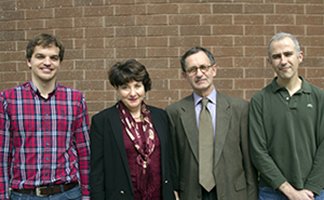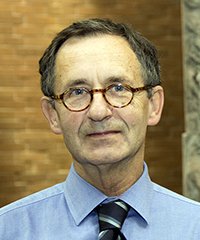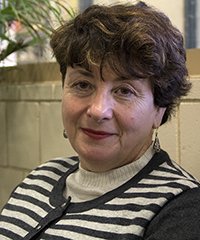Model Professors

Computational modeling is an essential tool of engineering practice—it allows engineers to study large, complex, real-world problems that would otherwise be very difficult or even impossible to solve. Four CEGE professors are developing numerical models that are being used as valuable tools in civil, environmental, and geo- engineering. Professor Henryk Stolarski strives to advance the existing models of structural analysis and continues to have a profound impact on the way engineers think about the analysis of structures, especially structural shells. Research Professor Sonia Mogilevskaya considers multiple views of materials from micro- to macro-scale in solving rock fracture problems. Assistant Professor Dominik Schillinger tackled a common obstacle and found a more efficient and accurate approach that will have wide-ranging impacts on the field of computational modeling. Assistant Professor Santiago Romero-Vargas Castrillón demonstrates that nano-scale models can have global-sized impacts.
“One of the greatest challenges in structural engineering is that, in their efforts to create safe and more economical structures, engineers cannot experiment with real-life physical models. At the same time failure to guarantee that structures are safe implies huge financial loses, or worse, loss of life. For that reason, engineers use mathematical models to explore various design options for large structures and to arrive at the final form.”
— Henryk Stolarski

HENRYK STOLARSKI’s first big breakthrough pointed to a problem rather than a solution. In 1981, Stolarski identified membrane locking, which appears in finite element analysis of curved structures (published in 1982). His initial work has had significant influence on this problem and subsequently generated much research. The problem still exists without a complete solution.
Prior to Stolarski’s discovery, engineers had observed an artificial stiffening in numerical models of curved structures; that is, the numerical analysis often predicted greater stiffness of a structure than did more precise analytic investigations (when analytic solutions were possible). It was generally assumed that the observed stiffening was due to shear effects or shear locking. Most researchers believed that the fundamental concepts and mechanics of finite element analysis of shells were well understood, so little research was devoted to this area…until Stolarski’s explanation of the phenomenon.
Stolarski saw what others had overlooked: the increased stiffness of the numerical model resulted from shortcomings of the approximations used to analyze the curved structures. The problem of membrane locking, as Stolarski defined it, stemmed from a discrepancy between membrane stiffness and bending stiffness of a structure, combined with the inability of the finite element model to adequately represent the interaction between the membrane and bending effects. Stolarski and Belytschko explained the reason behind the previously accepted artificial stiffening in 1982 in an influential paper “Membrane Locking and Reduced Integration for Curved Elements.”
Stolarski’s paper set off a renewed flurry of research through the 1980s and ’90s and resulted in several proposed improvements for the solution to the problem of membrane locking. Stolarski himself contributed another very helpful idea, an interesting observation on the interaction between shear locking and membrane locking.
In recent years, Stolarski’s understanding of modeling shells has found new applications in the analysis of blades for wind turbines. Stolarski’s model for wind turbine blades is based on a generalization of thin-walled structures theory. It features arbitrarily varying, curved, multi-cellular cross sections, which can be composed of many different anisotropic materials.
Stolarski continued to work on the problem of membrane locking and in 2007 investigated a new approach to the solution of the problem. He applied an established modeling method (Discontinuous Galerkin or DG) to structural shells, and showed that DG methods could lead to the elimination of membrane locking, provided that some additional parameters are carefully selected (Guzey, Cockburn, and Stolarski, 2007).
Most recently, Stolarski’s research has turned to anisotropic composite materials and structures composed of these materials. In this area, too, Stolarski’s contributions have been substantial. Working together with Sonia Mogilevskaya, he has shown that, in many important situations, inaccurate calculations would lead to faulty information about the overall properties or strength of the composite material (Mogilevskaya, Crouch, and Stolarski, 2008).
Stolarski has a clear understanding of the importance of models in the practice of engineering and has dedicated his career to the development of computational mechanics. He has significant influence in the field; however, Stolarski himself is quite humble about his contributions. “I’ve been lucky to have two big breakthroughs in my career,” says Stolarski, “one early on and one more recently. Discoveries, or even small advancements, in such an established area as mechanics cannot be planned; they seem to happen by chance. I often struggle to understand the problem and find a solution to it, and then—a solution comes to me somewhat unexpectedly.” His fellow researchers more readily acknowledge his contributions. His work is characterized by deep insight and far reaching consequences, and he is well respected (and often cited) by his fellow researchers.

DOMINIK SCHILLINGER tackled a challenge that had long limited the usefulness of computational modeling. The problem is that before a model can be used, an engineer, architect, designer, or programmer must meticulously define the shape(s) used to represent the object being modeled. This step requires that each surface of an object be described with great accuracy.
Thus, setting up complex computer models takes expertise, time, and focused attention. Schillinger, and others working in this field, saw that the valuable tool of computational modeling could be used by more people if this step of modeling could be made more automatic, could require less programming, and could eliminate more possibility of error. For example, surgeons and their patients would benefit greatly from a modeling tool that could take data and show how a patient’s heart was pumping and what might be hindering blood flow. However, surgeons are not typically expert computer programmers.
So Schillinger devotes his research to developing computational methods and tools for practical problems. He works to improve the efficiency of existing computational modeling tools (making them faster, more accurate, and more automatic) and to create simulation methods for problems that cannot be studied with existing tools---and he has seen success in these goals!
Schillinger developed the isogeometric method, which brings greater efficiency to finite element computer modeling. The isogeometric modeling could speed up the process of creating and running computer simulations, thus benefiting a broad array of applications.
Schillinger’s method moves toward that goal by using an established mesh or grid system, rather than requiring that a new mesh be set for each modeling instance. The isogeometric method has been tested in mechanical, biomedical, and structural applications. In his research, Schillinger works on many problems that fall outside the traditional areas of civil engineering work, yet he is applying mechanical techniques and numerical methods developed within civil engineering. “I take the tools and put them to use on practical problems, as I suspect many of our alumni working in industry do: take what they learned at the University and put it to work in new areas. I hope to help students make similar transfer of skills.”
Schillinger is quick to acknowledge that his research is not a solo effort. He learned this lesson clearly when working with Professor Tom Hughes at the University of Texas at Austin and he strives to build that collaborative spirit into his own research team.
Schillinger has gotten good early feedback on his method. The ubiquitous nature of computer simulations makes Schillinger’s new method so important. It has been predicted that Schillinger’s new simulation technology will strongly influence the current design process in mechanical and civil engineering and that the time savings could be 80% (TUMM). And in 2012, Schillinger received the John Argyris Award of the International Association for Computational Mechanics (IACM), the most prestigious award for young scientists in computational mechanics for developing this new method. Schillinger says the positive recognition feels good, but knows that any new method must stand the test of time before its true value is known.
Even though Schillinger works in so many different areas, he solidly identifies himself as a civil engineer. “Civil engineering is my training, it is my home.”

SONIA MOGILEVSKAYA considers multiple views of materials from micro- to macro-scale and seeks elegance in all applications.
Mogilevskaya's degree is in mathematics and her expertise is in the area of computational mechanics, with special emphasis on fracture problems involving geomaterials, or more generally, composite materials, using techniques known as boundary element methods. She has collaborated for many years with Steve Crouch, who is currently the Dean of the College of Science and Engineering. Together they developed a computational methodology of modeling composite materials, that is, materials such as rock that consist of more than one component.
In studying these types of fracture problems, scale is important. At a large scale, a composite material appears homogeneous, the variety of the microstructure is not apparent, and the material can be characterized by the so-called overall (or effective) properties. At a small scale, variations can be seen. Crouch and Mogilevskaya have studied the microstructures of materials and how they affect their overall properties. A significant feature of their work is the capability to directly simulate a microstructure by numerous non-overlapping inhomogeneities (fibers or particles).
They are also interested in the local effects of microstructure, seeking to understand how local fields will affect the stiffness, strength, and failure of composite materials. Recently, together with Henryk Stolarski they developed a computational technique to model a new class of materials: nano materials.
About four years ago, Mogilevskaya decided to return her concentration to fracture mechanics because of all the work related to hydraulic fracturing applications. Most existing models for rock fracturing are either 2-dimensional or 3-dimensional with a lot of simplification because rock fracturing is a very complicated problem. Mogilevskaya is working with Joe Labuz and Emmanuel Detournay on a complete 3D computational model for fractures. Their idea is to develop a general computational algorithm that will be suitable for many different scenarios. They are focusing specifically on crack initiation and how to calculate the preferred crack path in order to predict fracture propagation and increase production of resource extraction operations.
The power of computational modeling has greatly increased during the past several decades. “When I was working on my dissertation in the early 80s,”says Mogilevskaya, “it was extremely challenging because that was when computers were the size of a room and punch cards were used for input. Even solving algebraic equations was very slow; what can now be done in about five minutes then took about a week. There was much interest in my dissertation because I was solving a three-dimensional fracture problem that was very challenging for the existing computers. My dissertation received enthusiastic responses of the leading specialists in solid mechanics and geomechanics.”
“In recent years, computer power has increased significantly and computational tools have become much more powerful. As always, this process has two sides. Increased computer power and symbolic computation makes mathematical modeling much easier and faster, but now many problems can be solved by brute force.
“When I work with students who use these new tools, I see that they often do not notice some of the similarities or interesting effects. I often still derive equations by hand because it helps me see patterns and interesting aspects that cannot be seen when the computer does that work. Of course, creativity still matters, but before computers got so powerful there was more need for our solutions to be creative, elegant. Still, new advances make computational modeling a very promising field for students and new researchers.”
Mogilevskaya’s research has practical implications in many areas. Rock is a very complicated medium. It is not an engineered medium, and so it will have faults and inconsistencies. These faults can impact safety in mining, drilling, construction. It is very important to analyze stress concentrations, initial stress states, and to predict how rock will break or react to additional stresses. It is all relative to safety in some sense.
Her work has applications in hydraulic fracturing computation, too, which is mostly related to more efficient ways to extract resources from the ground. Also it has applications in underground storage, such as CO2 sequestration. In that situation it is important to analyze the rock and ensure that the CO2 will remain contained within a certain layer and won’t escape.
The area of materials is a very fast developing area, especially nanomaterials. There are opportunities in several applications related to the characterization of such materials.
Because averaging is a part of every multi-scale model, Mogilevskaya’s work has indirect applications to many areas where boundary element methods are used to solve problems big or small.
Her most recent publication, “On “Strange” Properties of Some Symmetric Inhomogeneities,” was completed with Henryk Stolarski and was published in the July 2015 Proceedings A of The Royal Society. Currently, she is writing a textbook with Steve Crouch on boundary element methods and their applications.
SANTIAGO ROMERO-VARGAS CASTRILLÓN demonstrates that nano-scale models can have global-sized impacts. A chemical engineer by training, Romero-Vargas Castrillón completed his doctoral research at Princeton University, studying nano-confined, interfacial, and hydration water using molecular simulation. He wanted to apply his chemical knowledge to work on environmental issues, and so went on to do post-doctoral research at Yale University with Dr. Menachem Elimelech, where he worked on developing low-fouling membranes for water separations.
Romero-Vargas Castrillón studies processes on a very fine scale. He uses molecular simulation methods (Monte Carlo and Molecular Dynamics) to study the properties of water near interfaces and in nanoscopic confinement. As an environmental engineer, he is especially interested in water-solid interfaces, which are prevalent in natural and engineered systems. He uses molecular simulations to understand the molecular-level interactions between molecules commonly found in water effluents and materials of environmental relevance. One such system is the interface formed by a membrane for water purification, which can be thought of as a filter with pores that are small enough to let water through while retaining most contaminants. Membrane-based processes for water purification, such as seawater desalination by reverse osmosis, hold significant promise in augmenting the water inventory. However, a problem affecting membrane materials is their propensity towards fouling, a process by which oily compounds clog the membrane by sticking onto the membrane surface. He uses molecular simulation to understand the interactions leading to membrane “clogging.” He aims to use this molecular-level understanding to design “non-stick” coatings for membrane surfaces and to formulate membranes with improved fouling resistance.
Another goal of his computational modeling work is to understand the properties of water in confined geometries, such as in porous materials. Water in confinement is of both fundamental and practical importance. He is fascinated by an observation of fundamental relevance: depending on the interactions between water and the confining material, water may evaporate or freeze at room temperature and pressure. In the context of environmental engineering, he uses molecular simulation to understand water transport across the membrane material. He also aims to formulate ways to improve the ability of a membrane to reject contaminants, such as small, uncharged compounds, which are only sparsely rejected by state-of-the-art reverse osmosis membranes.
Molecular simulation allows him to determine the structural, thermodynamic, and dynamic properties of matter at the molecular scale. To accomplish this, an empirical function, known as the force field, is used to describe the interactions between molecules, which in conjunction with computer methods grounded in classical statistical mechanics and Newtonian mechanics, are used to study the properties of the system. Molecular simulation is thus concerned with phenomena that occur over molecular length scales (roughly a billionth of a meter) and time scales (billionth to a millionth of a second) that are typically orders of magnitude smaller than those of relevance to continuum computational mechanics.
Romero-Vargas Castrillón acknowledges that teaching is an integral part of research. “I learn so much by dealing with the questions students raise.”